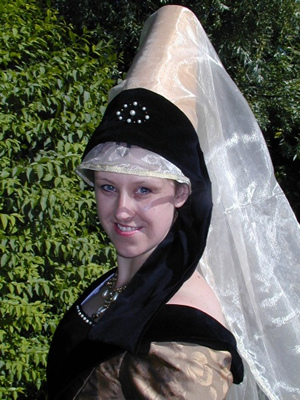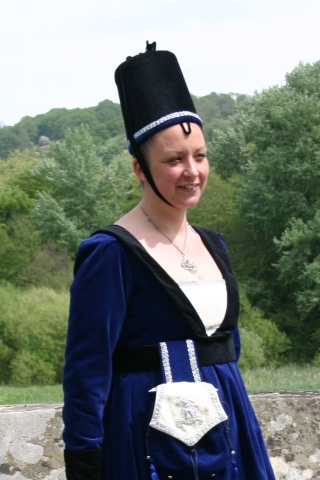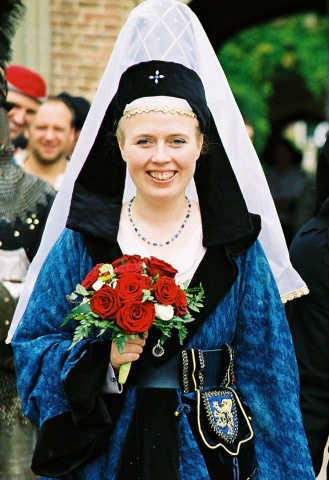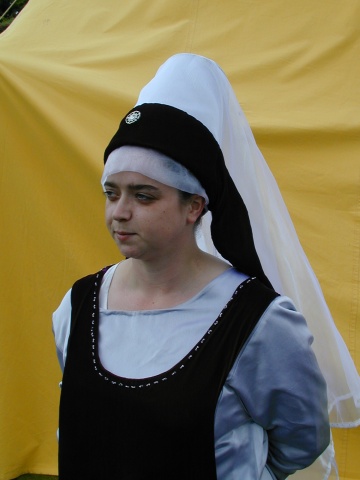
Historical Hats, Costumes & Accessories |
||
|
Home Crown Hood and Liripipe Man´s Cap Chaperon Torque Bycocket Crispinette Tressour Crispinette Nebule Templars Cross Tree Headdress Heart Shaped Hennin Attor de Gibet Jewelled Coif Hennin Flowerpot Hennin Halo Bonnet Reticulated Caul Flemish Hood Early Gable Headdress Tudor/Elizabethan Pouch Gloves Wedding Dresses Specialist Commissions Kats Kittens Authentic Effigy Based Headwear Miscellaneous Contact Links |
The Hennin C.1450 - 1470
The Hennin would have been covered in brilliantly coloured silks, velvets and "other costly stuff" (gold and silver tissue) as well as being richly and heavily embroidered. Very transparent veils would have hung down the back, almost to the floor in some cases or tucked under the arm. Other veils fell gracefully over the eyes; some were worn under the chin (like the C13th Barbette) and called a Turkey Bonnet (though it is uncertain that the style actually came from Turkey.) Some Hennin’s also had double veils hemmed with "rich stuff." Hair would not have been visible as it was considered "unfashionable" so it would have been drawn tightly away from the forehead, into a tight bun, high up on the crown of the head. The Hennin was placed over this. High pointed "Steeple Hennin's" were extremely popular on the continent, but was worn in England only by the most fashionable of Noblewoman. In France, the higher the Hennin, the higher the rank of the wearer. The Château de Vincennes was obliged to alter the doors so that the Queen and her ladies were able to enter rooms when in full dress. In Italy some "Steeple Hennins" were "half an ell high" (3/4 of a metre high). A preaching Friar called Thomas Conecte held an "Anti-Hennin Crusade" which ended in a bonfire of these "Steeple Hennins." The next day, before the ashes were hardly cold, fresh steeples adorned the Ladies heads higher than before. Many maids must have sat sewing all night! Another preacher, a Carmelite, made children run after women who wore these headdresses and cry "a hennin! a hennin!" Many examples of these headdresses can be seen on Monumental Brasses in various churches throughout England. The effigy of Lady Crosby 1466 in Great St Helens Church, London is one of them. The Hennin was worn by upper and middle classes but the lower class continued to wear their hair in the style of the previous century. By 1470 this Hennin was replaced by the "Flowerpot" or "Butterfly Hennin."
Headdress Design © 2001 - 2011|Site Design © 2005, 2006, 2007, 2008, 2009, 2010, 2011, 2012, 2013 All Items produced by Kats Hats © are subject to full copyright and may not be reproduced under any circumstances. Individuals have my permission to print single copies of the pictures or texts on this website for research for non-commercial purposes and private study provided Kats Hats © name, the copyright notice and this permission notice are preserved on all copies. Linking to this site is allowed without permission. For any other use please contact me. | |
 The
The 

